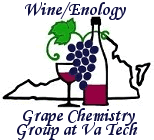 Enology Notes #60, September 5, 2002
Enology Notes #60, September 5, 2002
To: Regional Wine Producers
From: Bruce Zoecklein, Head, Enology-Grape Chemistry Group, Virginia Tech
Subject: Upcoming Enology Programs - Juice and Wine Analysis Short Course, January 8 and 9, 2003; Red Wine Fermentation with Oak; High Potassium/High pH
Juice and Wine Analysis Short Course. The Enology-Grape Chemistry Group will offer a two-day juice and wine analysis short course on January 8 and 9, 2003. This program will be a hands on, practically oriented laboratory course. It will be conducted in the teaching laboratory of the Food Science and Technology Building at Virginia Tech.
This program will include the following:
Registrants will participate in hands-on analysis. Analysis will be supplemented with a laboratory manual and discussions concerning the practical winemaking significance of each test.
Enrollment is Limited: The short course will be limited to a total of 14 participants. Only one person per bonded winery may register. You must register for both days. Registration preference will be given to Virginia bonded winery representatives that register BEFORE FRIDAY, NOVEMBER 1, 2002. After that date, open enrollment will be offered if space is available. Preference will be given to those already in the commercial wine industry. You will not be registered until your check is received!!! Cost: $350 per person, due by November 1, 2002, checks payable to:
Bruce Zoecklein, Foundation Account, Virginia Tech.
Mail to:
Bruce Zoecklein
Head, Enology-Grape Chemistry Group
Department of Food Science & Technology
Virginia Tech - 0418
Blacksburg, VA 24061
Course fee is non-refundable.
Red Wine Fermentation with Oak. Several previous editions of Enology Notes and the Vintner’s Corner hard copy newsjournal have discussed the benefits of red wine fermentation with oak.
The following are important points to consider:
Extraction of oak compounds during fermentation may help to solubilize tannins and maintain color stability. Aldehyde compounds extracted from toasted oak may help to cross-link anthocyanins and tannins, perhaps in a way similar to what occurs during microoxygenation.
The presence of cross links allow for a close proximity of anthocyanins and phenolic polymers and favors the formation of stacked or copigmented anthocyanins. Copigmented anthocyanins are responsible for a disproportionally large percentage of spectral color.
Fermentation with wood favors the precipitation of about 1/3 of the ellagic tannins (harsh phenol) thus potentially making a more structurally integrated product.
High Potassium/High pH. Two common problems we have with most red varieties in Virginia are elevated pH’s and the accumulation of high levels of potassium at harvest. Potassium uptake is believed to be regulated by an enzyme system that allows cations like potassium to be exchanged for protons (H+) from organic acids. This exchange increases the upward shift in pH.
There is no evidence to suggest a strong relationship between soil potassium and must potassium, except in cases of severe soil deficiency or excess. The availability of potassium in the soil, soil moisture, soil exchange capacity, size and age of the root system, number of clusters per vine, vine vigor and leaf shading all influence the potassium uptake.
Shallow soils and younger vines are believed to contain more potassium in the upper root system which may be easily translocated to the fruit.
The longer the fruit is on the vine, the greater is the potassium uptake and pH elevation. This is a down side, but is usually off-set by increases in varietal aroma/flavor and phenol maturity.
Understand the potential detriments of elevated pH in reds and attempt to keep the finished wine below pH 3.8 or 3.9. A red wine with a pH above this upper range will have diminished primary fruit aromas and a nonharmonious, soapy tactile impression in the mouth.
Must potassium greater than about 1500 mg/L (almost all Virginia red varieties) will give a pH increase of at least 0.2 pH units with pomace contact.
Musts with an initial low titratable acidity and high pH should be targeted for pre-fermentation acid adjustments to about 3.6, perhaps lower if you anticipate an upward shift of greater than 0.2 pH with pomace contact. Here, experience with your fruit is very important.
Be prepared to make pre-fermentation acid additions. While there may be a need for post-fermentation touch-up, additions up front will help to produce a wine where the acid is well integrated.
Precision and accuracy in your pH and TA analyses are critical!
Also remember that high pH musts are more susceptible to microbiological degradation. Increase the concentration of sulfur dioxide added to the must to avoid this.
Subscription to Enology Notes. All past Enology Notes and Vintner's Corner newsjournals are posted on the Enology-Grape Chemistry Group's web site at: http://www.fst.vt.edu/zoecklein/index.html or http://www.vtwines.info/. Enology Notes are slightly different in content from the subscription based Vintner's Corner newsjournal.
To be added to the Enology Notes list serve send an email message to bzoeckle@vt.edu with the word "ADD" or "REMOVE" in the subject line.
Dr. Bruce Zoecklein
Associate Professor and Enology Specialist
Head Enology-Grape Chemistry Group
Department of Food Science and Technology
Virginia Tech
Blacksburg VA 24061
Enology-Grape Chemistry Group Web address: www.vtwines.info or www.fst.vt.edu/zoecklein/index.html
Phone: (540) 231-5325
Fax: (540) 231-9293
Email: bzoeckle@vt.edu